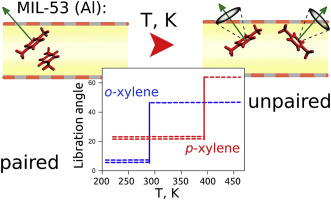Microporous and Mesoporous Materials ( IF 4.8 ) Pub Date : 2020-03-09 , DOI: 10.1016/j.micromeso.2020.110155 Alexander E. Khudozhitkov , Sergei S. Arzumanov , Daniil I. Kolokolov , Alexander G. Stepanov

|
With regard to understanding the effect of the dynamics of xylenes confined in the MOFs pores on the origin of xylene isomers separation, the mobility of para and ortho isomers of xylene in MIL-53(Al) MOF has been studied by solid-state 2H NMR. It is inferred that both isomers perform rotational and librational motions of the aromatic ring plane. The geometry, rates and energy barriers of the detected rotational modes for the molecules confined in the channels have been determined. The rotation around the axis perpendicular to the plane of aromatic ring is obliged with pairwise arrangement of xylene molecules along 1D channels of the MOF. The evolution of motional patterns with temperature shows that the pairwise arrangement of ortho isomer in the channels is held till 300 K, whereas the pairs are stable up to 405 K for the para isomer. This was rationalized by stronger interaction of o-xylene with the channel walls, while π–π intermolecular interaction is stronger for p-xylene. Due to stronger interaction between the unpaired molecules and MOF walls o-xylene exhibits notably higher temperature of the molecules desorption from the channels (494 K). In contrast, the p-xylene is capable to leave the channels of MIL-53 already at 405 K, moving in the channels predominantly in pairs. The different motional behavior of xylene isomers provides the conditions for a faster translational mobility along the MOF channel of para compared to the ortho isomer, thus accounting for the molecular mechanism behind the separation selectivity for xylene isomers.
中文翻译:

固态2 H NMR探测MIL-53(Al)MOF中二甲苯异构体的动力学
为了了解封闭在MOF孔中的二甲苯动力学对二甲苯异构体分离的起源的影响,已通过固态2 H研究了MIL-53(Al)MOF中二甲苯的对位和邻位异构体的迁移率NMR。可以推断,两种异构体均执行芳环平面的旋转运动和自由运动。已经确定了检测到的限制在通道中的分子的旋转模式的几何形状,速率和能垒。围绕垂直于芳环平面的轴的旋转必须沿MOF的1D通道成对排列的二甲苯分子。运动模式随温度的演变表明,正交的成对排列通道中的异构体保持到300 K,而对位异构体的对则稳定到405K 。这可以通过邻二甲苯与通道壁的更强相互作用来实现,而对二甲苯的π–π分子间相互作用则更强。由于未配对分子与MOF壁之间的相互作用更强,邻二甲苯的分子从通道解吸的温度显着提高(494 K)。相反,对二甲苯能够以405 K的速度离开MIL-53通道,主要成对移动。二甲苯异构体的不同运动行为提供了条件沿的MOF通道更快的平移移动性对与邻位异构体相比,这解释了二甲苯异构体分离选择性背后的分子机理。











































 京公网安备 11010802027423号
京公网安备 11010802027423号